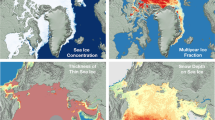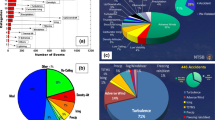Abstract
Measurements of atmospheric aerosols and trace gases using the laser radar (lidar) techniques, have been in progress since 1985 at the Indian Institute of Tropical Meteorology, Pune (18°32′N, 73°51′E, 559 m AMSL), India. These observations carried out during nighttime in the lower atmosphere (up to 5.5 km AGL), employing an Argon ion / Helium-Neon lidar provided information on the nature, size, concentration and other characteristics of the constituents present in the tropical atmosphere. The time-height variations in aerosol concentration and associated layer structure exhibit marked differences between the post-sunset and pre-sunrise periods besides their seasonal variation with maximum concentration during pre-monsoon / winter and minimum concentration during monsoon months. These observations also revealed the influence of the terrain of the experimental site and some selected meteorological parameters on the aerosol vertical distributions. The special observations of aerosol vertical profiles obtained in the nighttime atmospheric boundary layer during October 1986 through September 1989 showed that the most probable occurrence of mixing depth lies between 450 and 550 m, and the multiple stably stratified aerosol layers present above the mixing depth with maximum frequency of occurrence at around 750 m. This information on nighttime mixing depth / stable layer derived from lidar aerosol observations showed good agreement with the height of the ground-based shear layer / elevated layer observed by the simultaneously operated sodar at the lidar site.
Similar content being viewed by others
References
Carswell, A. I. (1983), Lidar measurements of the atmosphere,Canad. J. Phys.,61: 378–395.
Chanin, M. L. and Hauchecorne, A. (1991), Lidar study of the structure and dynamics of the middle atmosphere,Indian J. Radio and Space Phys.,20: 1–11.
Crutzen, P. J., Delany, A. C., Greenberg, J., Haagenson, P., Heidt, L., Lueb, R., Pollock, W., Wartburg, A. and Zimmerman, P. (1985), Tropospheric chemical composition measurements in Brazil during the dry season,J. Atmos. Chem.,2: 233–256.
Devara, P. C. S. and Ernest Raj, P. (1987), A bistatic lidar for aerosol studies,IETE Tech. Rev.,4: 412–415.
Devara, P. C. S. and Ernest Raj, P. (1989), Remote sounding of aerosols in the lower atmosphere using a bistatic CW Helium-Neon lidar,J. Aerosol Sci.,20: 37–44.
Ernest Raj, P., Devara, P. C. S. (1989), Some results of lidar aerosol measurements and their relationship with meteorological parameters,Atmos. Environ.,25A: 656–660.
Fiocco, G. (1984), Lidar systems for aerosol studies: an outline,Handbook for Middle Atmosphere Programme (MAP),13: 56–68.
Hanel, G. (1976), The properties of atmospheric aerosol particles as function of relative humidity at thermodynamic equilibrium with the surrounding moist air,Adv. Geophys.,19: 73–188.
Khemani, L. T., Momin, G. A., Naik, M. S., Kumar, R. and Murty, Bh. V. R. (1985), Observations of Aitken nuclei and trace gases in different environments in India,Water, Air and Soil Poll.,24: 131–141.
Killinger, D. K. and Mooradian, A. (1983),Optical and Laser Remote Sensing, Springer-Verlag, Berlin.
Killinger, D. K. and Menyuk, N. (1987), Laser remote sensing of the atmosphere,Science,235: 37–45.
McClatchey, R. A., Fenn, R. W., Selby, J. E. A., Volz, F. E. and Garing, J. S. (1971), Optical Properties of the Atmosphere,AFCRL-71-0279, US Air Force.
McClatchey, R. A., Fenn, R. W., Selby, J. E. A., Volz, F. E. and Garing, J. S. (1972), Optical Properties of the Atmosphere,AFCRL-72-0497, US Air Force.
Poole, H. E., Cox, J. W., Couch, R. H. and Fuller, W. H., (Jr) (1988), A lidar technology experiment from space shuttle, (Private communication).
Sasano, Y., Shigematsu, A., Shimizu, H., Takeuchi, N. and Okuda, M. (1982), On the relationship between the aerosol layer height and the mixed layer height determined by laser radar and low level radiosonde observations,J. Met. Soc. Japan,60: 889–895.
Zuev, V. E. (1982),Laser Beams in the Atmosphere, Plenum Publishing, New York.
Author information
Authors and Affiliations
Rights and permissions
About this article
Cite this article
Devara, P.C.S., Raj, P.E. Lidar measurements of aerosols in the tropical atmosphere. Adv. Atmos. Sci. 10, 365–378 (1993). https://doi.org/10.1007/BF02658142
Received:
Revised:
Issue Date:
DOI: https://doi.org/10.1007/BF02658142




